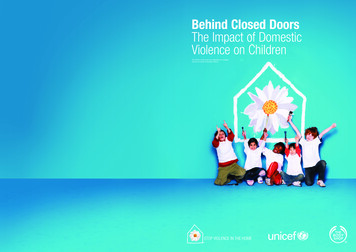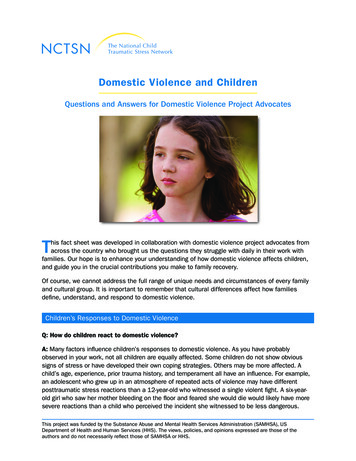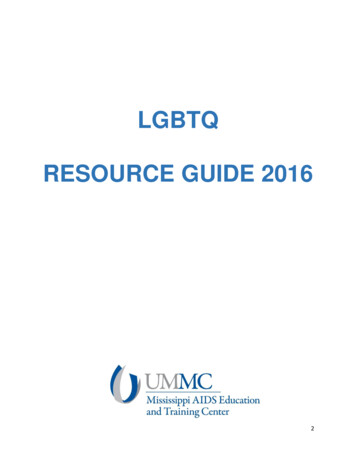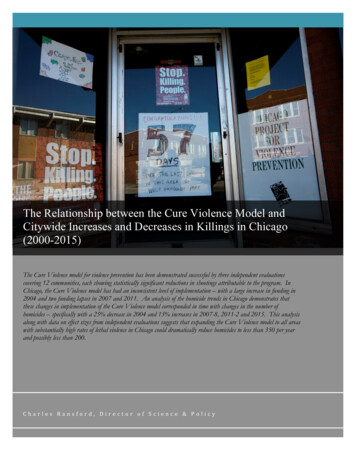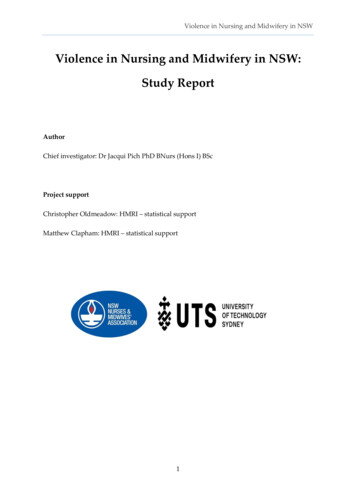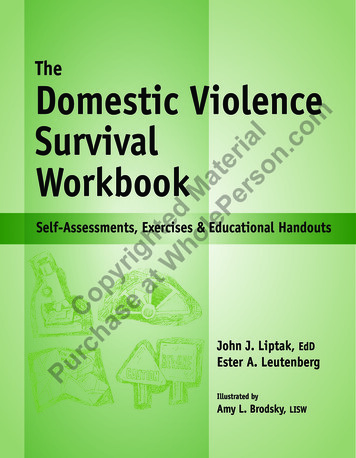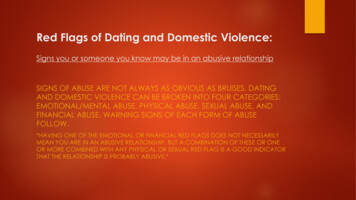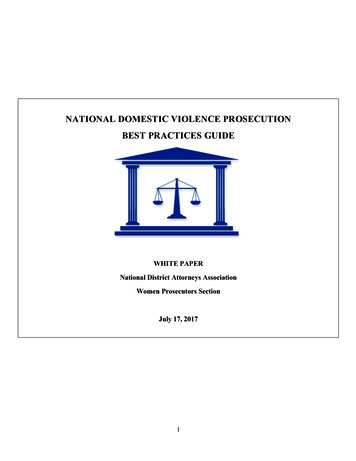
Transcription
NATIONAL DOMESTIC VIOLENCE PROSECUTIONBEST PRACTICES GUIDEWHITE PAPERNational District Attorneys AssociationWomen Prosecutors SectionJuly 17, 20171
The National Domestic Violence Prosecution Best Practices Guide is a living documenthighlighting current best practices in the prosecution of domestic violence.It was inspired by the Women Prosecutors Section of the National District AttorneysAssociation (NDAA) and a National Symposium on the Prosecution of Domestic ViolenceCases, hosted by the NDAA and Alliance for HOPE International in San Diego in October2015. The two-day national symposium included 100 of our nation’s leading prosecutors reenvisioning the prosecution of domestic violence cases in the United States.Prosecutors and allied professionals are encouraged to continue developing this guide bycontributing information on emerging best practices. NDAA recognizes that funding, localrules, or other state laws or local restrictions may prevent an office from adopting the variousapproaches suggested. This guide is not intended to replace practices and procedures already inoperation, but to simply inform and recommend practices that are effective and consistentthroughout the nation.For additional edits to this living document, contact Tracy.Prior@sdcdaorg, Chair, DomesticViolence Subcommittee, NDAA Women’s Section.2
TABLE OF CONTENTSIntroduction . 4Definitions . 6Victim Recantation, Minimization, and Self-Blame . 7Cultural Competence . 9Tenets of Case Handling. 13Evidence-Based Prosecution . 14The Prosecutor’s Role . 16Enlisting Victim Advocacy . 17Risk Assessment and Safety Planning . 18Discouraging Dual Arrests . 19Continued Investigation of the Defendant . 20Near and Nonfatal Strangulation . 21Multijurisdictional Prosecutions . 23Charging the Domestic Violence Case . 24Arguing Bail and the Initial Appearance . 25Preliminary Hearings . 26Witness Preparation . 26Motions in Limine . 27Rape Shield Laws . 27Trial Issues and Strategies . 28Plea Bargains . 34Disposition of Domestic Violence Cases . 35Multidisciplinary Collaborative Efforts . 36Trauma-Informed Prosecutors . 40Police Body-Worn Cameras . 42Conclusion . 433
INTRODUCTIONDomestic violence is no longer a private matter to be resolved by the family alone.1 Rather, it is a social,economic, and public health concern. Nationally, about 31.5% of women and 27.5% of men have experiencedphysical violence by an intimate partner during their lifetimes. Of these, about 22.3% of women and 14% ofmen have experienced severe physical violence.2 In addition to immediate physical injuries, victims of domesticviolence suffer long-term social and psychological harms such as being fearful or concerned for their safety;developing symptoms of posttraumatic stress disorder; missing school; and finding themselves in need ofhousing, legal services, and medical care.3 About 47.1% of women and 46.5% of men have experiencedpsychological aggression by an intimate partner during their lifetimes.4The toll is not only felt by the individual victim but by the entire family. Violence committed in front of familymembers, particularly children, can have physical, developmental, and psychological ramifications on thosewho witness the violence or try to intervene.5 The incidence of child abuse is higher in homes where women areabused by their partners, and these children are at a high risk of becoming victims or abusers as adults.6 Recentresearch has documented high rates of domestic violence perpetration and victimization in the lives of childrengrowing up in domestic violence homes.7 In a 2013 study by Sam Houston University, researchers trackedchildren growing up in domestic violence homes for 20 years. Children from 78.6% of the families becameperpetrators by the age of 21.8 Children from 75% of the families became victims of domestic violence by theage of 21.9Society as a whole is further impacted by the demand domestic violence generates. The Centers for DiseaseControl and Prevention (CDC) reports that in 1995, the cost of domestic violence against women exceeded 5.8billion.10 Of this cost, 4.1 billion were directly attributable to medical and mental healthcare costs with almost 1.8 billion attributed to the indirect cost of lost productivity.11 On average, victims lose about eight milliondays of paid work.12 When converted to today’s dollars, the cost of intimate partner violence (IPV), rape,physical assault, and stalking is more than 8.3 billion.13Domestic violence is not, and cannot remain thought to be, a private matter. The primary goals of this documentare to increase victim safety, offender accountability, and community accountability by challenging prosecutorsto aggressively prosecute domestic violence cases when the evidence supports prosecution and promotingmultidisciplinary, multi-agency collaborations, including co-located service models such as family justice1National District Attorneys Association’s Policy Positions on Domestic Violence (pp. 1-33). (2004). Monterey, CA. Adopted byBoard of Directors; See also Urban, R.P. (2000). Nevada Domestic Violence Resource Manual (pp. 1-399), NV: The Urban Group.2Centers for Disease Control and Prevention, Prevalence and Characteristics of Sexual Violence, Stalking, and Intimate PartnerViolence Victimization — National Intimate Partner and Sexual Violence Survey, United States, 2011, 1-18, 63 (SS08) (2014).3Id.4Id.5National District Attorneys Association Policy Positions on Domestic Violence, Adopted by the Board of Directors, October 23,2004 (Monterey, CA);6Domestic Violence & the Courtroom Knowing the Issues. Understanding The Victim, 4 (2012), American Judges iolence-the-courtroom.pdf7Kelly E Knight et al., Generational Cycles of Intimate Partner Violence in the US: A Research Brief (2013).8Id.9Id.10National Center for Injury Prevention and Control, Costs of Intimate Partner Violence Against Women in the United States 32(2003).11Id. at 31.12Id. at 18.13Injury Prevention & Control : Division of Violence Prevention, Centers for Disease Control and Prevention atepartnerviolence/consequences.html., citing Max W, Rice DP, Finkelstein E, BardwellRA, Leadbetter S. The economic toll of intimate partner violence against women in the United States. Violence Vict. 2004;19(3):259–72.4
centers and similar multi-agency approaches and coordinated community responses. This document focuses onstrategies for the successful prosecution of cases even when victims are unable or unwilling to participate inprosecution. It also includes a discussion of ways prosecutors can play a valuable role in advocating forcommunity-oriented interventions to help support survivors and their children in breaking the vicious,generational cycle of family violence.Justice is telling the truth about injustice,repairing the harm as much as humanly possible,and working to change the conditions that caused the injustice in the first place.—Desmond Tutu5
DEFINITIONSThe language, definition, and elements of domestic violence in criminal statutes vary by state, and prosecutorsand allies should have knowledge of the definitional statutes applicable in their jurisdiction. Common termsinclude domestic violence, domestic abuse, domestic battering, family violence, spousal abuse, and partner orfamily member assault.14 Federal agencies and researchers such as the CDC often employ the term “intimatepartner violence” (IPV),15 and this document therefore uses the CDC’s definition of IPV to define domesticviolence.The CDC defines IPV as “a serious, preventable public health problem that affects millions of Americans.”16The CDC further categorizes IPV into four types:(1) Physical violence, defined as “the intentional use of physical force with the potential for causingdeath, disability, injury, or harm”17(2) Sexual violence, subdivided into five categoriesa. Rape or penetration of victimb. Victim made to penetrate someone elsec. Non-physically pressured unwanted penetrationd. Unwanted sexual contact, defined as the “intentional touching of the victim or making thevictim touch the perpetrator, either directly or through clothing . . . without the victim’sconsent”18e. Non-contact unwanted sexual experiences,19 defined as the “unwanted exposure to sexualsituations (e.g., pornography); verbal or behavioral sexual harassment; threats of sexualviolence to accomplish some other end; and /or unwanted filming, taking, or disseminatingphotographs of a sexual nature of another person”20(3) Stalking, defined as “repeated, unwanted attention and contact that causes fear or concern for one’sown safety or the safety of someone else (e.g., family member or friend)”21(4) Psychological aggression, defined as the “use of verbal and non-verbal communication with theintent to harm another person mentally or emotionally, and/or to exert control over another person”22Although the definition of the term domestic violence is limiting, there is an interrelationship between domesticviolence and crimes involving drug and alcohol use and abuse, animal cruelty, elder abuse, and child abuse.23Domestic violence has a dire impact on particularly vulnerable populations; recognizing and acknowledging theunique characteristics of these populations is therefore imperative.14National District Attorneys, supra note 1.Injury Prevention & Control, supra note 10.16Intimate Partner Violence: Definitions, Centers for Disease Control and Prevention atepartnerviolence/definitions.html. See also Centers for Disease Control andPrevention, Intimate Partner Violence Surveillance Uniform Definitions and Recommended Data Elements (2015).17Id.18Id.19Id.20Id.21Id.22Id.23National District Attorneys Association, supra at note 1.156
VICTIM RECANTATION, MINIMIZATION, AND SELF-BLAMEVictims and survivors of domestic violence may present very differently than victims of other crimes. Thesevictims often recant, minimize, or altogether deny their abuse as a result of the power and control that permeatestheir intimate partner relationship.Victims may recant their statements to law enforcement by minimizing the incident, denying it happened,faulting him or herself, or refusing to participate in prosecution. Domestic violence victims differ from victimsof other crimes in that the domestic violence victim and the offender are never strangers. Instead, victims ofdomestic violence have an intimate relationship that is often spousal, romantic, sexual, parental, social,psychological, and/or financial. While victims of other crimes may want justice, vindication, and restitution,many victims of domestic violence do not; instead, they want the abuse to stop or their abuser to be taken forthe night but not necessarily arrested and prosecuted.24 Furthermore, months into the case, victims of domesticviolence may have personally resolved the conflict by putting the arrest behind them and continuing their liveswith their abuser.25 If this is the case, victims may perceive their personal resolution, however fragile andtemporary, to be threatened by the stress and upheaval of criminal prosecution.26 They may then becomeuncooperative and hostile, leading to recantation. Recantation and nonparticipation in prosecution may beassociated with the victim’s financial dependence on their abuser; psychological vulnerability; perceptions of anunsympathetic criminal justice response; poor access to advocates; emotional attachment to the offender;family, cultural, or religious pressure to remain with their abuser; shame or embarrassment; fear of deportation;and feelings of guilt. Many victims of domestic violence view recantation as the safest and most prudent courseof action.27Recantation encompasses a vast majority of the domestic violence prosecutor’s caseload, occurring in about80% of domestic violence criminal cases.28 Strategizing ways to address and respond to recantation is thereforea bulk of the prosecutor’s work. When a victim recants, minimizes, or refuses to participate in prosecution,criminal conviction rates for domestic violence are impacted. The United States Supreme Court’s 2004 decisionin Crawford v. Washington limited the prosecutor’s ability to pursue a domestic violence case without thevictim’s testimony.29 The results of this limiting decision in Crawford are evident in a study conducted by theAdministrative Office of the Courts for Washington State from 1999 to 2010. Most notably, beginning in 2004,conviction rates for domestic violence decreased significantly.30The forms of control the offender exerts over the victim may be depicted in the Duluth’s Model Power andControl Wheel.31 The wheel represents the dynamics of domestic violence, those being a cyclical pattern ofactions intentionally used for power and control. This often doubles as an excellent tool to use wheninterviewing a victim. The root of the violence—the need for power and control—lies in the center of the wheel.24Linda McGuire, Criminal Prosecution of Domestic prosecutev/prosecutev.html (1999); see also Rebecca McKinstry, “An Exercise inFiction”: The Sixth Amendment Confrontation Clause, Forfeiture by Wrongdoing, and Domestic Violence in Davis v. Washington, 30HARV. J.L. & GENDER 531, at 532, 539.25Id.26Id.27Lundy Bancroft & Jay Silverman, The Batterer as Parent: Addressing the Impact of Domestic Violence on Family Dynamics 99(2002).28Joan Meier, Davis/Hammon, Domestic Violence, and the Supreme Court: The Case for Cautious Optimism, 105 MICH. L. REV.FIRST IMPRESSIONS 22–27 (2015). See also Andrew R Klein, Practical Implications of Current Domestic Violence Research Part II:Prosecution 2–92, National Institute of Justice (2009).29Crawford v. Washington, 541 U.S. 36, 68 (2005).30Sarah Veele, Domestic Violence in Washington State: 1999-2010, Washington State Center for Court Research 1-23.31Wheel Gallery, Domestic Abuse Intervention Programs Home of the Duluth Model ls.html. (While a reported 27.5% of men have experience physical violence, the Duluthmodel, developed for female victims, is still instructive in the intricacies of domestic violence). See also Nevada Domestic Violence,supra note 1.7
The spokes of the wheel represent the threats, intimidation, and coercion used to instill fear.32 The rimrepresents the acts of physical or sexual violence that hold the wheel together.33 The use of violence enables andreinforces the use of psychological behaviors their abuser employs to have power and control over the victim. Ina similar vein, witness tampering and intimidation is a significant problem in domestic violence cases due to theoffender’s manipulation and threats.34In addition to their abuser’s behavior, factors such as family, cultural, and religious pressures to remain withtheir abuser; shame or embarrassment; fear of deportation; and feelings of guilt may prevent a victim fromleaving their abuser and fully cooperating with law enforcement and prosecution. Victims may remain withtheir abusers for cultural or religious reasons, believing that the family must remain together, children need tobe raised by both parents, the victim must remain faithful to the abusive spouse, or it is the victim’sresponsibility to make the relationship work.35The prosecutor’s interests of offender accountability may conflict with the victim’s personal resolution of thecase. Prosecutors should therefore devise methods to most practicably address the goals of all parties involvedand to eliminate as many conflicts as possible.36 While the prosecutor’s goals are to ensure the safety of thevictim and community and to hold the offender accountable, the victim may want to continue his or herrelationship with their abuser. This right of the victim to continue the relationship should not be confused withthe obligation of the prosecutor to prosecute provable cases of abuse. The prosecutor should zealously prosecutethe offender while remaining sensitive to and respectful of the victim’s personal resolution of the case.37Prosecutors should not, however, confuse their role in holding offenders accountable for criminal behavior withthe victim’s often unrealistic belief that ending the prosecution will resolve the violence and abuse in therelationship.The prosecutor should avoid the temptation to blame the victim for being uncooperative or unwilling to testify.Often it is better to shift the focus from questioning why victims do not wish to testify and why victims staywith their abusers, to questioning why abusers batter and why intervention is necessary. Asking why victimsremain with abusers places the blame on the victim when it is the abuser who should be held accountable.38 Bylistening to the victim’s perspective; exploring mutual interests; and clarifying the roles of the victim, thedefendant, and the prosecutor, prosecutors may be able to reduce conflicts of interest and better help the victimunderstand why a prosecutor may prosecute irrespective of the victim’s reluctance to participate.39 The corecharge of the prosecutor is offender accountability, and prosecutors should not be misled by the false reality thatdismissing the case will solve the abuse or end the violence in the relationship.40Effective listening requires an awareness of the background beliefs and experiences particularly vulnerablepopulations hold.32Id.Id.34See AEquitas, The Prosecutors' Resource Witness Intimidation (2014), sourceIntimidation.pdf.35Nevada Domestic Violence, supra note 1.36National District Attorneys, supra note 1.37Id.38Nevada Domestic Violence, supra note 1.39Id.40Casey Gwinn and Gael Strack, Hope for Hurting Families: Creating Family Justice Centers Across America (2006), pp. 79-81.338
CULTURAL COMPETENCENative American VictimsAmong the American Indian and Alaska Native populations, an estimated 51.7% of women and 43.0% of menhave experienced physical violence by an intimate partner during their lifetimes.41 Native American victims aredisinclined to report domestic violence and be involved in the prosecution process for several reasons. Theircultures place great value on community, and coming forward may threaten this communal and familialharmony.42 Not unlike women of other cultures, Native American women may fear losing custody of theirchildren. Confusion surrounding federal and tribal jurisdiction may prevent offenders from being apprehended,prosecuted, and ultimately convicted.African-American VictimsAmong the African-American population, an estimated 41.2% of women and 36.3% of men have experiencedphysical violence from an intimate partner during their lifetimes.43 About 17.4% of African-American womenand 14.8% of African-American men have experienced sexual violence other than rape,44 and about 8.8% ofAfrican-American women have been raped during their lifetimes.45Prosecutors should understand and acknowledge concerns and fears unique to African-American victims. Inaddition to the abovementioned reasons, this population may be reluctant to report domestic violence to lawenforcement and participate in the prosecution of their abusers because of their suspicion of the justice system.They may also fear that they will not be believed, child protective services will become involved, or familialand communal units will be disrupted if they report “one of their own.”46African-American women victims are more likely to seek help from their social and religious communities, andthe prosecutor should enlist the aid of multidisciplinary teams that can also help address the victim’s basicneeds.Hispanic VictimsAmong the Hispanic population, an estimated 29.7% of women and 27.1% of men have experienced physicalviolence by an intimate partner during their lifetimes. About 9.9% of Hispanic women and 13.5% of Hispanicmen have experienced sexual violence other than rape by an intimate partner during their lifetimes, and 6.2% ofHispanic women have been raped during their lifetimes.Language barriers, immigration status, and cultural and religious beliefs may be responsible for Hispanicvictims’ reluctance to participate in the prosecution of their abusers. Among the groups that are least likely toreport, undocumented women have great fear of retaliation by both their abuser and their community. Theirabuser may have threatened to report them to the Immigration and Naturalization Service (INS), and theircommunity in whole or in part may also be undocumented and therefore unsupportive of any actions that maydraw attention to its members.LGBTQ VictimsAccording to the National Coalition of Anti-Violence Programs (NCAVP), of the 2,679 reports of intimatepartner violence received in 2012, 15.8% of victims experienced physical violence, 12.9% experienced41Centers for Disease Control and Prevention, supra note 2.Wisconsin Office of Justice Assistance, supra note 48.43Centers for Disease Control and Prevention, supra note 2.44Id.45Id.46Wisconsin Office of Justice Assistance, supra note 48.429
harassment, and 11.3% experienced threats by an intimate partner.47 This is consistent with the CDC’s 2010report estimating 43.8% of lesbian women and 26% of gay men have experienced physical violence, rape,and/or stalking by an intimate partner during their lifetimes.48Victims among the lesbian, gay, bisexual, transgender, and questioning (LGBTQ) community face uniquechallenges in reporting abuse and participating in the prosecution of their abuser. Their close-knit communityhas historically been under scrutiny and criticism, and as a result LGBTQ victims may be reluctant to report theabuse for fear of betraying their community or stalling the community’s efforts for social and legal recognition.LGBTQ victims may fear unequal treatment by the justice system, not being believed, or being “outed.”49 TheNCAVP reports that in 2012, in about a third of the cases reported to law enforcement, the victim was arrestedinstead of the abuser, and he or she experienced further verbal abuse and physical and sexual violence by thepolice.50Teenage VictimsIt is estimated that 71.1% of women and 58.2% of men have been victims of sexual violence, physical contact,or stalking by an intimate partner before 25 years of age. Of those victims, 23.2% of women and 14.1% of menfirst experienced one or more of these offenses before 18 years of age.51 Significantly, of those who experiencedabuse before 18 years of age, 23.1% of women and 14% of men first experienced abuse between the ages of 11and 17 years.52 Most strikingly, every year in the United States, about 1.5 million high school studentsexperience physical abuse by a dating partner.53Teenage victims are a particularly vulnerable population, and multidisciplinary teams should thereforeimplement teenage dating abuse and healthy relationships awareness campaigns. These teams should include,but not be limited to, educators, students, parents, counselors, community members, school boards, electedofficials, and advocates.Multidisciplinary teams can reach teenagers through press conferences, public services announcements, posters,social media, and media outreach. For example, in San Diego County, an awareness campaign included a pressconference at which the district attorney, the president of the Domestic Violence Council, the operation directorof Strong Hearted Native Women’s Coalition, and the San Diego Chargers kicker spoke; six public serviceannouncements played during 1,301 spots between February 7 and July 31, 2016, including two spots duringthe Super Bowl; 6,000 posters distributed to local schools, social services agencies, healthcare sites, and courts;information dispensed through social media accounts; and media outreach through radio and televisioninterviews.While utilizing the internet to raise awareness, multidisciplinary teams, and particularly prosecutors, shouldrecognize the implications the internet poses to the prosecution of offenders of teenage domestic violence. Forinstance, the defendant may try to utilize the teenage victim’s social media accounts to paint the victim in a badlight and attack his or her character and credibility. The offender may also utilize social media to continue the47National Coalition of Anti-Violence Programs (NCAVP), Lesbian, Gay, Bisexual, Transgender, Queer, and HIV-Affected IntimatePartner Violence in 2012 (2016), http://www.avp.org/storage/documents/ncavp 2012 ipvreport.final.pdf.48Centers for Disease Control and Prevention, The National Intimate Partner and Sexual Violence Survey 2010 Findings onVictimization by Sexual Orientation 19 (2013), http://www.cdc.gov/violenceprevention/pdf/nisvs sofindings.pdf.49Wisconsin Office of Justice Assistance, supra note 48.50NCAVP, supra note 63.51Centers for Disease Control and Prevention, supra note 2.52Id.53Break the Cycle, State Law Report Cards (2014), s.10
abuse through stalking and threats. To address the potential damage to both the victim and the prosecutionprocess, prosecutors should inquire into the victim’s social media accounts in the early interview stages.The trial phase of the prosecution process is also affected by factors unique to teenage victims. Teenagers areoften negatively stereotyped as drinkers and drug users, disrespectful, difficult, rebellious, and evenpromiscuous,54 and these stereotypes may seep into the courtroom. To prevent jurors from forming thesestereotypes, or to deconstruct them where they have already been formed, prosecutors should expose thesestereotypes early on by thoroughly learning about the individual teenager.Self-blame and the fears of legal and social repercussions, not being believed, or being judged may lead teenagevictims of domestic violence to omit, lie, or rationalize.55 If, for example, a teenager lies about consumingalcohol, the prosecutor should not call the teenager a liar but should instead explain that although the teenagershould not have drank, the focus of the prosecution is the violence against the teenager.56 Prosecutors can alsooffer expert witnesses to explain the reasons a teenager would omit or lie.Child Victims and WitnessesChildhood maltreatment is positively correlated with negative health and well-being later in life, as found by theAdverse Childhood Experiences (ACE) Study.57 Particular attention should therefore be given to child victimsand witnesses. Prosecutors should be mindful of how gender differences affect the experience of and responseto domestic violence, as studies show boys are more approving of violence than girls.58 Child victims andwitnesses should receive immediate medical and mental care. As a response to the ACE Study’s findings, manyjurisdictions across the country, such as Stearns County, Minnesota,59 are developing evidence-based, traumainformed practices to address the impact of witnessing domestic violence.60Studies show that compared to children who have not witnessed domestic violence, child witnesses of domesticviolence exhibit lower social competence and higher aggressive, antisocial, fearful, and inhibited behaviors.61One study found that higher aggressive behaviors may be the result
Jul 17, 2017 · July 17, 2017 . 2 The National Domestic Violence Prosecution Best Practices Guide is a living document highlighting current best practices in the prosecution of domestic violence. It was inspired by the Women Prosecutors Section of the National Dis

